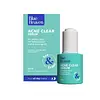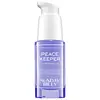What's inside
What's inside
 Key Ingredients
Key Ingredients

 Benefits
Benefits

 Concerns
Concerns

 Ingredients Side-by-side
Ingredients Side-by-side

Water
Skin ConditioningButylene Glycol
HumectantAzelaic Acid
BufferingGlycerin
HumectantSodium Hydroxide
BufferingBetaine
HumectantSodium PCA
HumectantPropanediol
SolventSalicylic Acid
MaskingChamomilla Recutita Extract
Skin ConditioningSodium Hyaluronate Crosspolymer
HumectantSodium Hyaluronate
HumectantSodium Acetylated Hyaluronate
HumectantHydrolyzed Sodium Hyaluronate
Skin ConditioningPentylene Glycol
Skin ConditioningZinc PCA
HumectantSaccharum Officinarum Extract
MoisturisingVaccinium Myrtillus Bud Extract
AntioxidantCitrus Aurantium Dulcis Fruit Extract
MaskingAcer Saccharum Extract
Skin ConditioningCitrus Medica Limonum Peel Extract
EmollientHydroxyethylcellulose
Emulsion StabilisingAllantoin
Skin ConditioningXanthan Gum
EmulsifyingPEG-40 Hydrogenated Castor Oil
EmulsifyingSalvia Officinalis Oil
MaskingMyristica Fragrans Kernel Oil
MaskingEugenia Caryophyllus Oil
Phenoxyethanol
PreservativeEthylhexylglycerin
Skin ConditioningDisodium EDTA
Water, Butylene Glycol, Azelaic Acid, Glycerin, Sodium Hydroxide, Betaine, Sodium PCA, Propanediol, Salicylic Acid, Chamomilla Recutita Extract, Sodium Hyaluronate Crosspolymer, Sodium Hyaluronate, Sodium Acetylated Hyaluronate, Hydrolyzed Sodium Hyaluronate, Pentylene Glycol, Zinc PCA, Saccharum Officinarum Extract, Vaccinium Myrtillus Bud Extract, Citrus Aurantium Dulcis Fruit Extract, Acer Saccharum Extract, Citrus Medica Limonum Peel Extract, Hydroxyethylcellulose, Allantoin, Xanthan Gum, PEG-40 Hydrogenated Castor Oil, Salvia Officinalis Oil, Myristica Fragrans Kernel Oil, Eugenia Caryophyllus Oil, Phenoxyethanol, Ethylhexylglycerin, Disodium EDTA
Salicylic Acid 2%
MaskingWater
Skin ConditioningAloe Barbadensis Leaf Juice
Skin ConditioningOctyldodecanol
EmollientAzelaic Acid
BufferingAlgin
MaskingDimethyl Isosorbide
SolventNeopentyl Glycol Diethylhexanoate
EmollientGlycerin
HumectantPropanediol
SolventDisteardimonium Hectorite
StabilisingAzelamidopropyl Dimethyl Amine
AntimicrobialSodium Polyacryloyldimethyl Taurate
Emulsion StabilisingSodium PCA
HumectantPotassium Azeloyl Diglycinate
Skin ConditioningBeta-Glucan
Skin ConditioningCarrageenan
Leptospermum Scoparium Branch/Leaf Oil
TonicMagnolia Officinalis Bark Extract
AntimicrobialPiper Nigrum Seed Extract
RefreshingSodium Hyaluronate Crosspolymer
HumectantPotassium Hydroxide
BufferingPhenoxyethanol
PreservativePropylene Carbonate
SolventKaolin
AbrasiveHydroxyethyl Acrylate/Sodium Acryloyldimethyl Taurate Copolymer
Emulsion StabilisingButylene Glycol
HumectantErythritol
HumectantPotassium Lactate
BufferingCaprylyl Glycol
EmollientChlorphenesin
AntimicrobialEthylhexylglycerin
Skin ConditioningXanthan Gum
EmulsifyingSodium Phytate
Citric Acid
BufferingBenzoic Acid
MaskingSodium Hydroxide
BufferingSorbic Acid
PreservativePolysorbate 60
EmulsifyingSorbitan Isostearate
EmulsifyingPentylene Glycol
Skin Conditioning1,2-Hexanediol
Skin ConditioningSodium Benzoate
MaskingSalicylic Acid 2%, Water, Aloe Barbadensis Leaf Juice, Octyldodecanol, Azelaic Acid, Algin, Dimethyl Isosorbide, Neopentyl Glycol Diethylhexanoate, Glycerin, Propanediol, Disteardimonium Hectorite, Azelamidopropyl Dimethyl Amine, Sodium Polyacryloyldimethyl Taurate, Sodium PCA, Potassium Azeloyl Diglycinate, Beta-Glucan, Carrageenan, Leptospermum Scoparium Branch/Leaf Oil, Magnolia Officinalis Bark Extract, Piper Nigrum Seed Extract, Sodium Hyaluronate Crosspolymer, Potassium Hydroxide, Phenoxyethanol, Propylene Carbonate, Kaolin, Hydroxyethyl Acrylate/Sodium Acryloyldimethyl Taurate Copolymer, Butylene Glycol, Erythritol, Potassium Lactate, Caprylyl Glycol, Chlorphenesin, Ethylhexylglycerin, Xanthan Gum, Sodium Phytate, Citric Acid, Benzoic Acid, Sodium Hydroxide, Sorbic Acid, Polysorbate 60, Sorbitan Isostearate, Pentylene Glycol, 1,2-Hexanediol, Sodium Benzoate
 Reviews
Reviews

Ingredients Explained
These ingredients are found in both products.
Ingredients higher up in an ingredient list are typically present in a larger amount.
Azelaic acid is a multitasker ingredient that helps treat acne, pigmentation, and irritation. It is a great option for sensitive skin.
What makes azelaic special?
The best thing about azelaic acid is it's gentleness. It's generally well-tolerated and safe to use alongside other actives like niacinamide or salicylic acid.
Unlike AHAs, azelaic acid will not make you photosensitive/sun sensitive.
You can find this ingredient naturally occurring in grains like wheat, rye, and barley. In cosmetics, azelaic acid is typically lab-made, which is more stable and effective.
Learn more about Azelaic AcidButylene Glycol (or BG) is used within cosmetic products for a few different reasons:
Overall, Butylene Glycol is a safe and well-rounded ingredient that works well with other ingredients.
Though this ingredient works well with most skin types, some people with sensitive skin may experience a reaction such as allergic rashes, closed comedones, or itchiness.
Learn more about Butylene GlycolEthylhexylglycerin (we can't pronounce this either) is commonly used as a preservative and skin softener. It is derived from glyceryl.
You might see Ethylhexylglycerin often paired with other preservatives such as phenoxyethanol. Ethylhexylglycerin has been found to increase the effectiveness of these other preservatives.
Glycerin is already naturally found in your skin. It helps moisturize and protect your skin.
A study from 2016 found glycerin to be more effective as a humectant than AHAs and hyaluronic acid.
As a humectant, it helps the skin stay hydrated by pulling moisture to your skin. The low molecular weight of glycerin allows it to pull moisture into the deeper layers of your skin.
Hydrated skin improves your skin barrier; Your skin barrier helps protect against irritants and bacteria.
Glycerin has also been found to have antimicrobial and antiviral properties. Due to these properties, glycerin is often used in wound and burn treatments.
In cosmetics, glycerin is usually derived from plants such as soybean or palm. However, it can also be sourced from animals, such as tallow or animal fat.
This ingredient is organic, colorless, odorless, and non-toxic.
Glycerin is the name for this ingredient in American English. British English uses Glycerol/Glycerine.
Learn more about GlycerinPentylene glycol is typically used within a product to thicken it. It also adds a smooth, soft, and moisturizing feel to the product. It is naturally found in plants such as sugar beets.
The hydrophilic trait of Pentylene Glycol makes it a humectant. As a humectant, Pentylene Glycol helps draw moisture from the air to your skin. This can help keep your skin hydrated.
This property also makes Pentylene Glycol a great texture enhancer. It can also help thicken or stabilize a product.
Pentylene Glycol also acts as a mild preservative and helps to keep a product microbe-free.
Some people may experience mild eye and skin irritation from Pentylene Glycol. We always recommend speaking with a professional about using this ingredient in your routine.
Pentylene Glycol has a low molecular weight and is part of the 1,2-glycol family.
Learn more about Pentylene GlycolPhenoxyethanol is a preservative that has germicide, antimicrobial, and aromatic properties. Studies show that phenoxyethanol can prevent microbial growth. By itself, it has a scent that is similar to that of a rose.
It's often used in formulations along with Caprylyl Glycol to preserve the shelf life of products.
Propanediol is an all-star ingredient. It softens, hydrates, and smooths the skin.
It’s often used to:
Propanediol is not likely to cause sensitivity and considered safe to use. It is derived from corn or petroleum with a clear color and no scent.
Learn more about PropanediolSalicylic Acid (also known as beta hydroxy acid or BHA) is a well-known ingredient for treating skin that struggles with acne and clogged pores. It exfoliates both the skin's surface and deep within the pores to help clear out buildup, control oil, and reduce inflammation.
Unlike AHAs (alpha hydroxy acids), salicylic acid is oil-soluble. This allows it to penetrate into pores which makes it especially effective for treating blackheads and preventing future breakouts.
Salicylic acid is also known for its soothing properties. It has a similar structure to aspirin and can calm inflamed or irritated skin, making it a good option for acne-prone skin that is also sensitive.
Concentrations of 0.5-2% are recognized by the U.S. FDA as an over-the-counter topical acne product.
It can cause irritation and/or dryness if one's skin already has a compromised moisture barrier, so it's best to focus on repairing that before introducing this ingredient into your routine.
While salicylic acid does not increase sun sensitivity, it’s still important to wear sunscreen daily to protect your skin.
If you are looking for the ingredient called BHA or Butylated Hydroxyanisole, click here.
Learn more about Salicylic AcidSodium Hyaluronate Crosspolymer is a type of hyaluronic acid. In fact, it is modified version of hyaluronic acid.
The structure of Sodium Hyaluronate Crosspolymer allows it to stay in the skin's top layer for a longer period of time. This allows for even more hydration and humectant action than hyaluronic acid.
These are some other common types of Hyaluronic Acid:
Learn more about Sodium Hyaluronate CrosspolymerSodium Hydroxide is also known as lye or caustic soda. It is used to adjust the pH of products; many ingredients require a specific pH to be effective.
In small amounts, sodium hydroxide is considered safe to use. However, large amounts may cause chemical burns due to its high alkaline.
Your skin has a natural pH and acid mantle. This acid mantle helps prevent harmful bacteria from breaking through. The acid mantle also helps keep your skin hydrated.
"Alkaline" refers to a high pH level. A low pH level would be considered acidic.
Learn more about Sodium HydroxideSodium PCA is the sodium salt of pyroglutamic acid. It is naturally occurring in our skin's natural moisturizing factors where it works to maintain hydration.
The PCA stands for pyrrolidone carboxylic acid, a natural amino acid derivative.
This ingredient has skin conditioning, anti-inflammatory, and humectant properties. Humectants help hydrate your skin by drawing moisture from the air. This helps keep your skin moisturized.
Learn more about Sodium PCAWater. It's the most common cosmetic ingredient of all. You'll usually see it at the top of ingredient lists, meaning that it makes up the largest part of the product.
So why is it so popular? Water most often acts as a solvent - this means that it helps dissolve other ingredients into the formulation.
You'll also recognize water as that liquid we all need to stay alive. If you see this, drink a glass of water. Stay hydrated!
Learn more about WaterXanthan gum is used as a stabilizer and thickener within cosmetic products. It helps give products a sticky, thick feeling - preventing them from being too runny.
On the technical side of things, xanthan gum is a polysaccharide - a combination consisting of multiple sugar molecules bonded together.
Xanthan gum is a pretty common and great ingredient. It is a natural, non-toxic, non-irritating ingredient that is also commonly used in food products.
Learn more about Xanthan Gum